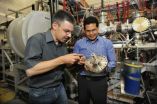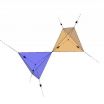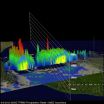(Press-News.org) EAST LANSING, Mich. — Why, after millions of years of evolution, do organisms build structures that seemingly serve no purpose?
A study conducted at Michigan State University and published in the current issue of The American Naturalist investigates the evolutionary reasons why organisms go through developmental stages that appear unnecessary.
"Many animals build tissues and structures they don't appear to use, and then they disappear," said Jeff Clune, lead author and former doctoral student at MSU's BEACON Center of Evolution in Action. "It's comparable to building a roller coaster, razing it and building a skyscraper on the same ground. Why not just skip ahead to building the skyscraper?"
Why humans and other organisms retain seemingly unnecessary stages in their development has been debated between biologists since 1866. This study explains that organisms jump through these extra hoops to avoid disrupting a developmental process that works. Clune's team called this concept the "developmental disruption force." But Clune says it also could be described as "if the shoe fits, don't change a thing."
"In a developing embryo, each new structure is built in a delicate environment that consists of everything that has already developed," said Clune, who is now a postdoctoral fellow at Cornell University. "Mutations that alter that environment, such as by eliminating a structure, can thus disrupt later stages of development. Even if a structure is not actually used, it may set the stage for other functional tissues to grow properly."
Going back to the roller coaster metaphor, even though the roller coaster gets torn down, the organism needs the parts from that teardown to build the skyscraper, he added.
"An engineer would simply skip the roller coaster step, but evolution is more of a tinkerer and less of an engineer," Clune said. "It uses whatever parts that are lying around, even if the process that generates those parts is inefficient."
An interesting consequence is that newly evolved traits tend to get added at the end of development, because there is less risk of disrupting anything important. That, in turn, means that there is a similarity between the order things evolve and the order they develop.
A new technology called computational evolution allowed the team to conduct experiments that would be impossible to reproduce in nature.
Rather than observe embryos grow, the team of computer scientists and biologists used BEACON's Avida software to perform experiments with evolution inside a computer. The Avidians – self-replicating computer programs – mutate, compete for resources and evolve, mimicking natural selection in real-life organisms. Using this software, Clune's team observed as Avidians evolved to perform logic tasks. They recorded the order that those tasks evolved in a variety of lineages, and then looked at the order those tasks developed in the final, evolved organism.
They were able to help settle an age-old debate that developmental order does resemble evolutionary order, at least in this computationally evolving system. Because in a computer thousands of generations can happen overnight, the team was able to repeat this experiment many times to document that this similarity repeatedly occurs.
###
Additional MSU researchers contributing to the study included BEACON colleagues Richard Lenski, Robert Pennock and Charles Ofria. The research was funded by the National Science Foundation.
Michigan State University has been working to advance the common good in uncommon ways for more than 150 years. One of the top research universities in the world, MSU focuses its vast resources on creating solutions to some of the world's most pressing challenges, while providing life-changing opportunities to a diverse and inclusive academic community through more than 200 programs of study in 17 degree-granting colleges.
COLUMBIA, Mo. – Millions of American cancer survivors experience chronic discomfort as a result of lymphedema, a common side effect of surgery and radiation therapy in which affected areas swell due to protein-rich fluid buildup. After reviewing published literature on lymphedema treatments, a University of Missouri researcher says emphasizing patients' quality of life rather than focusing solely on reducing swelling is critical to effectively managing the condition.
Jane Armer, professor in the MU Sinclair School of Nursing and director of nursing research at Ellis Fischel ...
A large-scale review of national patient records reveals that although survival rates are the same, the cost of treating trauma patients in the western United States is 33 percent higher than the bill for treating similarly injured patients in the Northeast. Overall, treatment costs were lower in the Northeast than anywhere in the United States.
The findings by Johns Hopkins researchers, published in The Journal of Trauma and Acute Care Surgery, suggest that skyrocketing health care costs could be reined in if analysts focus on how caregivers in lower-cost regions manage ...
This press release is available in German.
So-called "superheavy" elements owe their very existence exclusively to shell effects within the atomic nucleus. Without this stabilization they would disintegrate in a split second due to the strong repulsion between their many protons. The constituents of an atomic nucleus, the protons and neutrons, organize themselves in shells. Certain "magic" configurations with completely filled shells render the protons and neutrons to be more strongly bound together.
Long-standing theoretical predictions suggest that also in superheavy ...
A new 3-D view of the body's response to infection – and the ability to identify proteins involved in the response – could point to novel biomarkers and therapeutic agents for infectious diseases.
Vanderbilt University scientists in multiple disciplines combined magnetic resonance imaging (MRI) and imaging mass spectrometry to visualize the inflammatory response to a bacterial infection in mice. The techniques, described in Cell Host & Microbe and featured on the journal cover, offer opportunities for discovering proteins not previously implicated in the inflammatory response.
Access ...
How strong can earthquakes in Germany be? Where in Europa are the earthquake activities concentrated? These questions are the basis for risk assessments and become relevant when it comes to the safety of buildings or the generation of tsunami.For the first time, scientists of the GFZ German Research Centre for Geosciences have succeeded in setting up a harmonized catalogue of earthquakes for Europe and the Mediterranean for the last thousand years. This catalogue consists of about 45000 earthquakes, reported in the latest issue of the „Journal of Seismology".
Earthquakes ...
Athens, Ga. – Shifting sands and tides make it difficult to measure accurately the amount of beach that's available for recreation, development and conservation, but a team of University of Georgia researchers has combined several remote sensing technologies with historical data to create coastal maps with an unsurpassed level of accuracy.
In a study published in the August issue of the journal Tourism Management, they apply their technique to Georgia's Jekyll Island and unveil a new website that allows developers, conservationists and tourists access to maps and data ...
Vaccination against the hepatitis A virus (HAV) in children two years of age and younger remains effective for at least ten years, according to new research available in the August issue of Hepatology, a journal of the American Association for the Study of Liver Diseases (AASLD). The study found that any transfer of the mother's HAV antibodies does not lower the child's immune response to the vaccine.
The World Health Organization (WHO) estimates that 1.4 million cases of HAV occur worldwide each year. HAV affects the liver and typically occurs in areas with poor sanitation ...
The sought-after equanimity of "living in the moment" may be impossible, according to neuroscientists who've pinpointed a brain area responsible for using past decisions and outcomes to guide future behavior. The study, based on research conducted at the University of Pittsburgh and published today in the professional journal Neuron, is the first of its kind to analyze signals associated with metacognition—a person's ability to monitor and control cognition (a term cleverly described by researchers as "thinking about thinking.")
"The brain has to keep track of decisions ...
Magnetic monopoles, entities with isolated north or south magnetic poles, weren't supposed to exist. If you try to saw a bar magnet in half, all you succeed in getting are two magnets, each with a south and north pole. In recent years, however, the existence of monopoles, at least in the form of "quasiparticles" consisting of collective excitations among many atoms, has been predicted and demonstrated in the lab. Now Stephen Powell, a scientist at the Joint Quantum Institute (JQI*) and the University of Maryland, has sharpened the theoretical framework under which ...
NASA's Tropical Rainfall Measuring Mission satellite, known as TRMM can measure the rate rain is falling with a tropical cyclone from its orbit in space, and data from August 9 reveals areas of heavy rainfall in Tropical Storm Ernesto as it heads for a second landfall in Mexico.
The TRMM satellite saw tropical storm Ernesto on August 9, 2012 at 0656 UTC (2:36 a.m. EDT) after it moved from the Yucatan Peninsula into the Gulf of Mexico. An analysis of TRMM Microwave Imager (TMI) and Precipitation Radar (PR) rainfall shows that powerful convective thunderstorms were dropping ...




